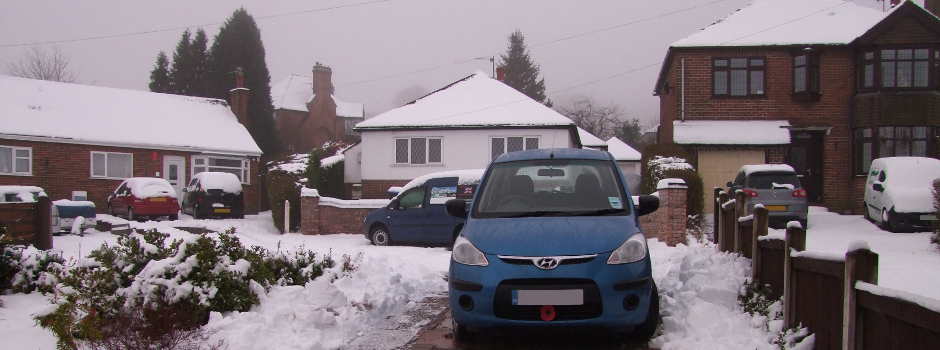Car insurance is not only a legal requirement, but it can be extremely helpful for breakdown recovery and collisions caused by bad weather. It’s not a miracle worker though, and even the best car insurance policy in the world can’t prevent you from running into problems.
Give yourself the best chance of a smooth journey, whatever the winter weather throws at you, with these top tips.
Getting your car winter-ready
This doesn’t mean fitting a snowplough, but cold snaps can put a lot more strain your vehicle. Just a few tweaks and top-ups here and there can help you see your car though the colder weather.
Tyres – Shallow tread and wet or icy conditions do not mix well. Check your treads and look for any cracks and bulges which may signal the need for a new tyre. If you live somewhere remove that’s prone to heavy snowfall, you might want to consider winter tyres for greater control and traction, or snow socks – stretchy fabric covers that slip over the two drive wheels for added grip on snow and ice.
Battery – Car batteries can become flat if your car is not driven for a while, but especially suffer in cold, damp weather where they have to work that much harder to start the engine on a cold morning. Check your battery on a weekly basis during the winter months. Heaters, iPods and sat navs can drain the battery quickly if left on when the engine’s not running, so it’s best to switch them off before switching off your engine, and keep them off when you come to re-start your car.
Wiper blades – If you want your wiper blades to withstand heavy rain, snow and hail to keep your windscreen clear, they need to be in good order. These are cheap to replace and easy to change, and vital for your visibility. Use lukewarm water to part them from a frozen windscreen to avoid unnecessary damage.
Essential solutions – If you’re setting off on a long journey, you need to make sure you have plenty of fuel, sufficient oil, coolant, screen wash and anti-freeze. You don’t know how long you may get held up in bad weather or heavy traffic, and by checking all these solutions you’ll further avoid becoming stranded through lack of fuel, a frozen engine, and poor visibility.
Your winter emergency kit
Stock up on the essentials before winter sets so you have them to hand just in case. Your emergency kit should include:
- Ice scraper and de-icer
- Torch and spare batteries, or a wind-up torch
- Warm clothes and blankets
- Boots
- First aid kit
- Jump start cables
- Food and a warm drink in a thermos
- Shovel
- Reflective warning sign
- Road atlas
- Sunglasses for snow glare
- Phone charger
Before setting off
Give yourself enough time before you set off to completely de-ice your car, remove any snow from your roof and clear any frost or snow from your lights. If you don’t have any de-icer, use lukewarm water to clear your windscreen – boiling water could crack the glass.
Don’t leave your engine running unattended while warming up your car as you run the real risk of it being stolen.
Plan your route and check the weather forecast before you go. Things may change while you’re on the road, but most car radios can be set to give travel updates for your area. If you have pulled over, you can also check the Highways Agency and the RAC for traffic updates, and the Met Office for weather information.
Driving in the snow
Driving in a higher gear means your tyres are turning slower which reduces the risk of slips and slides. If you need to slow down it’s better to shift down gear rather than suddenly braking, as this can lead to skidding. Moving off in second gear can reduce wheel slip when you’re beginning your journey.
Leave a greater gap between you and the car in front to allow for reduced brake effectiveness, accelerate gently, and keep your speed down.
Compact snow in the wheel tracks will be more slippery than fresh snow so try and avoid driving in these on a road that hasn’t been gritted. If you do find yourself moving into a skid, keep both hands on the steering wheel and don’t brake too suddenly.
Most cars are not designed to be waterproof and don’t cope well driving through deep water. When moving through water keep your speed steady to push the water in front of the car and test your brakes afterwards. If you break down in the water, restarting your engine could cause further damage, so it’s better to call your breakdown provider.
if you’re unsure of water depth, it’s better to avoid altogether than running the risk of causing serious and expensive damage to your engine – something that you will have to pay for if the insurer decides that it could have been avoided
Driving through water connected to swollen rivers or becks is extremely dangerous and should never be attempted.
Keep your speed down in shallow standing water so your tyres don’t lose contact with the road. This is known as aquaplaning and will cause your steering to feel very light. if this happens, ease off the accelerator until you regain control.
Driving in Fog
If visibility is less than 100m, your headlights need to be on. Familiarise yourself with your front and rear fog lights before setting off.
Keep your headlights dipped, and listen out for any oncoming traffic at junctions by winding down your window.
For more tips or any further assistance, the team here at Independent Insurance Services would be happy to help you further. Call us on 01303 22 11 88 or email us to find out more.

